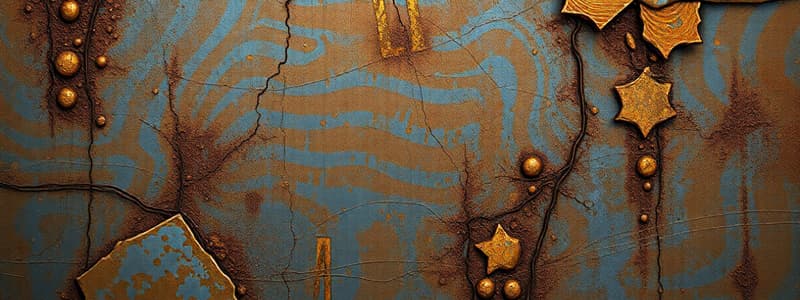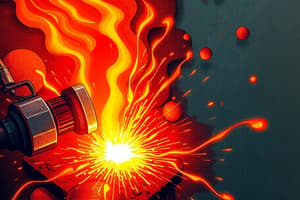Podcast
Questions and Answers
What is the primary difference between tarnish and stain on dental restorations?
What is the primary difference between tarnish and stain on dental restorations?
- Tarnish affects only gold restorations, while stain affects only composite restorations.
- Tarnish results from chemical reactions forming films like oxides, while stain is due to pigment-producing agents and debris. (correct)
- Tarnish involves only the accumulation of plaque, while stain involves calculus formation.
- Tarnish is caused by hard deposits exclusively and Stain is caused by soft deposits
Which of the following best describes the process of tarnish formation on a metal surface?
Which of the following best describes the process of tarnish formation on a metal surface?
- The formation of a chemical film, such as a sulfide or oxide, that dulls the metal's brightness. (correct)
- Adsorption of food debris contributing to discoloration
- The deposition of calculus, leading to a hard, brown layer.
- The growth of microorganisms and mucin, forming a soft film.
A dental patient complains about discoloration on their amalgam fillings. What is the LEAST likely cause and recommended action?
A dental patient complains about discoloration on their amalgam fillings. What is the LEAST likely cause and recommended action?
- Adsorbed food debris; recommend a specific mouthwash (correct)
- Exposure to drugs containing iron and mercury; consider material replacement.
- Formation of sulfide films due to reaction with saliva; recommend improved oral hygiene.
- The presence of plaque; professional cleaning.
Why is it important to differentiate between tarnish and stain on dental restorations when planning treatment?
Why is it important to differentiate between tarnish and stain on dental restorations when planning treatment?
Which of the following scenarios would MOST likely lead to the formation of tarnish on a dental restoration?
Which of the following scenarios would MOST likely lead to the formation of tarnish on a dental restoration?
Flashcards
Tarnish
Tarnish
Surface discoloration or dulling of a metal's brightness due to a chemical film.
Calculus
Calculus
Hard deposits (light yellow to brown) that contribute to tarnish and surface discoloration.
Plaque
Plaque
Soft deposits and films composed of microorganisms and mucin, leading to discoloration.
Oxide, Sulfide, Chloride Films
Oxide, Sulfide, Chloride Films
Signup and view all the flashcards
Stain/Discoloration Causes
Stain/Discoloration Causes
Signup and view all the flashcards
Study Notes
- Tarnish is surface discoloration on a metal, a slight loss, or alteration of the surface finish/luster.
- Tarnish is when a metal surface is dulled/discolored through the formation of a chemical film like sulfide/oxide.
Causes
- Tarnish occurs from the formation of hard and soft deposits on a surface
- Calculus: light yellow to brown hard deposit
- Plaque: soft deposit/films of microorganisms and mucin
- Tarnish may arise on a metal from thin films such as oxides, sulfides, and chlorides
- Stain/discoloration arises from pigment producing bacteria, drugs containing chemicals (iron/mercury), and adsorbed food debris.
Studying That Suits You
Use AI to generate personalized quizzes and flashcards to suit your learning preferences.




